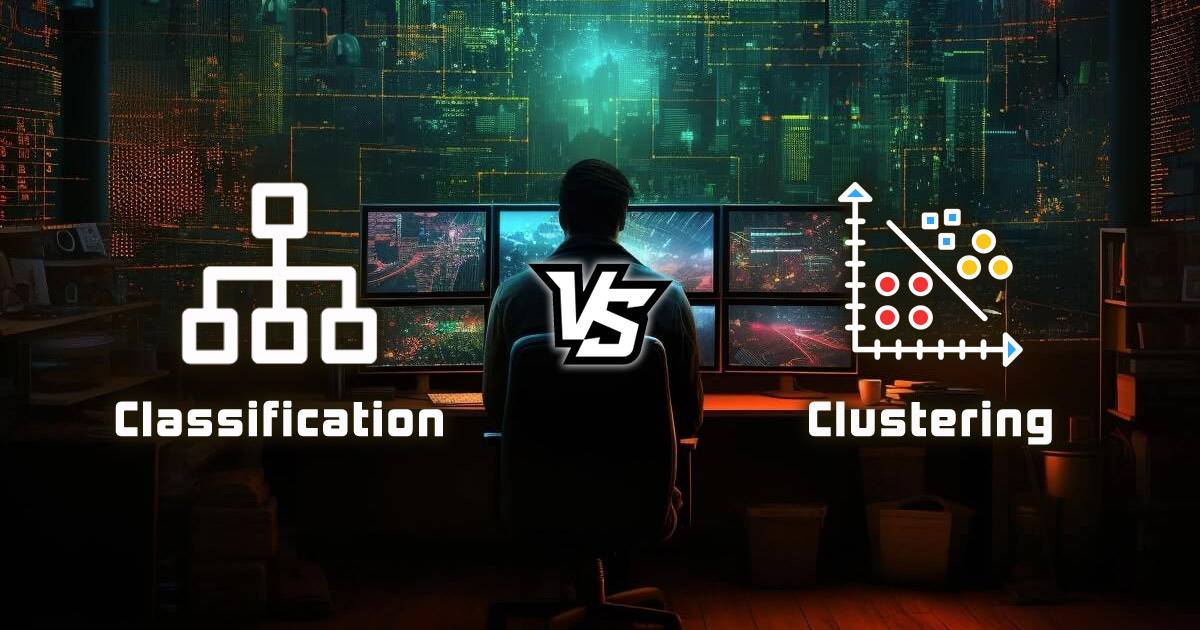Understanding Classification and Clustering in Machine Learning: A Simple Guide

In machine learning, there are two main ways to group things: classification and clustering. This can be confusing at first.
At first glance, classification and clustering seem alike. They both use algorithms to find patterns in data and group things together. But in practice, they’re pretty different.
Understand each method, the algorithms used, what they’re used for, and how they’re different.
What is Classification?
Classification, also known as supervised learning, is when an algorithm learns to sort data into specific groups or labels using training data. This training data has examples with known labels, which helps the algorithm learn patterns in the data. The goal of classification is to construct a model capable of reliably predicting the label for fresh data.
Some common applications of classification include:
- Email spam detection (determining if an email is spam or not)
- Sentiment analysis (classification of text as good, negative, or neutral)
- Fraud detection (classifying transactions as fraudulent or legitimate)
- Image recognition (classifying images like animals, objects, or landscapes)
What is Clustering?
Clustering is an unsupervised learning technique that groups data items with comparable properties. Unlike classification, clustering doesn’t need predefined labels. Instead, it finds patterns and similarities in the data to form clusters.
The goal of clustering is to uncover natural groupings in the data, which can help explore data and find insights. Clustering algorithms try to create clusters with similar data points while keeping clusters different from each other.
Clustering has applications in a variety of fields, including:
- Customer segmentation (grouping clients according to their behavior and preferences)
- Anomaly detection (identification of odd data items that differ considerably from clusters)
- Image segmentation (dividing an image into relevant sections or objects)
- Recommender systems (grouping users or items based on similar preferences or characteristics)
Key Differences Between Classification and Clustering
While both classification and clustering are essential techniques in data analysis and machine learning, the difference between classification and clustering lies in several key aspects.
Supervised vs. Unsupervised Learning:
- Classification is a supervised learning technique that relies on labeled training data.
- Clustering is an unsupervised learning strategy that does not rely on labeled data.
Output:
- In classification, the output is a discrete class or label assigned to each data point.
- Clustering produces a set of clusters, or groups, of comparable data points.
Prior Knowledge:
- Classification requires prior knowledge of the classes or labels to train the model effectively.
- Clustering does not require prior knowledge of the class labels; it discovers patterns and groupings within the data.
Evaluation Metrics:
- Classification models are often evaluated using metrics such as accuracy, precision, recall, and F1-score, which assess the model’s ability to predict the proper class labels.
- Clustering algorithms are often evaluated using metrics like the silhouette score, Davies-Bouldin index, or Calinski-Harabasz index, which measure the compactness and separation of the identified clusters.
Applications:
- Classification is widely used in applications where predicting category labels or classes is critical, such as spam detection, sentiment analysis, and image recognition.
- Clustering is often employed for exploratory data analysis, customer segmentation, anomaly detection, and recommender systems, where the primary goal is discovering natural groupings or patterns within the data.
Choosing Between Classification and Clustering
The choice between classification and clustering depends on the specific problem you are trying to solve and the nature of the available data. Here are some general guidelines:
- If you have labeled data and want to forecast the class or category of fresh data points, classification is the best option.
- If you have unlabeled data and want to discover natural groupings or patterns within the data, clustering is a suitable approach.
- If you have a mix of labeled and unlabeled data, you may consider semi-supervised learning techniques that combine elements of both classification and clustering.
It’s important to note that in some cases, both classification and clustering can be employed in a complementary manner. For example, clustering can be used to identify potential groups or patterns within the data, and then classification can be applied to label or categorize these groups further.
Clustering vs. Classification: Know the Technique to Use
In data analysis and machine learning, classification and clustering are essential tools with different purposes. Classification predicts labels for new data based on labeled training data, while clustering finds patterns in data without using labels.
Data scientists need to understand the difference between classification and clustering to choose the proper technique. Classification is suitable for predicting labels, while clustering is excellent for exploring data and finding patterns.
Mastering both techniques helps data professionals gain insights, make better decisions, and solve many real-world problems in different fields.
